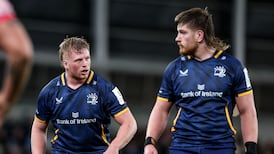Ireland can look toward the Six Nations in an altogether more optimistic frame of mind than was the case at this point a year ago. In the fall-out from the quarter-final defeat to Argentina, and adapting to life without Paul O'Connell, a fresh batch of injuries had Joe Schmidt setting the then reigning champions a target of a top-half finish.
This time round, the inner self-belief that ought to come with the wins over New Zealand and Australia, both in themselves, each other and their systems, regardless of personnel available or used, is impossible to measure accurately, but it is all largely in the positive.
Nothing illustrates the improved strength in depth more than the impact made by Peter O’Mahony, as one of eight backrowers employed in the four games, and effectively the sixth choice backrower in the three heavyweight games.
Conveyor belt
Granted, backrow has always been Ireland's best equipped area, but even so the emergence of Tadhg Furlong, Josh van der Flier and Garry Ringrose, who had started just three Tests prior to this month, demonstrates that the Irish conveyor belt is still humming nicely.
In addition, some of the stalwarts remain as good as ever, even if as Joe Schmidt admitted after Saturday's game, every team still has its relatively irreplaceable players, and uppermost amongst these are the centurion and captain Rory Best, and, of course, Conor Murray.
Johnny Sexton and Robbie Henshaw would have been viewed in similar light, yet in the heel of the hunt Ireland beat Australia without either of their first-choice 10 and 12, not to mention the loss of Rob Kearney, Andrew Trimble and Jared Payne. Admittedly, Payne's first-half performance, and the second-half without him, underlined his under-stated importance to the team as well.
The strength in depth and improved attacking width, on the back of rock solid set-pieces, mauling, carrying and breakdown work of the pack, have Irish fans feeling a little giddy again. Already there is talk of a potential Grand Slam shoot-out on St Patrick’s weekend with England, who by then could be seeking a world record 19th Test win in a row.
This window underlined why Argentina, South Africa and, less so now, Australia all fell behind New Zealand in the post-World Cup rugby championship. And so, after losing all seven head-to-head meetings in the World Cup, the Six Nations enjoyed eight wins out of 14 matches with their Championship counterparts, with England-Australia to come next Saturday.
Revenge win
Ireland start off away to Scotland, whose inventive, attacking performance against Australia might easily have yielded a revenge win rather than a 23-22 loss, and even then they did beat Argentina before routing Georgia. They are also a more dangerous team than a year ago.
Italy may have bookended their month with a 68-10 hammering by New Zealand and an embarrassing 19-17 loss to Tonga without their suspended skipper and talisman Sergio Parisse, but a first ever victory over South Africa constituted the first shoots of a resurgence under Conor O’Shea.
Perhaps though the most ominous signs of a resurgence came from the Stade de France. After thumping Samoa 52-8, only missed kicks denied France a deserved victory over Australia instead of a 25-23 defeat, and similarly, their more inventive game could easily have yielded a win over the All Blacks last Saturday rather than a 24-19 loss which hinged on a 14-point turnover in the shape of Beauden Barrett’s intercept try.
Guy Noves looks to be building something, and something significantly more French than the power game of his predecessor. In addition to the powerful carrying game of Louis Picamoles et al, a settled French team, with Camille Lopez now entrusted in their problem position of 10 and Wesley Fofana at last feeling the love from a French national coach,being employed in midfield and producing in a French jersey.
In the game against Australia, France made 34 offloads and 18 line breaks. Against New Zealand, they made 31 offloads and 17 line breaks. They really did leave two wins behind, but for which we would be viewing their threat in the Six Nations in all the more menacing a light.
Embarrassing ease
Then there is Wales in the Millennium Stadium in the penultimate round, where Ireland lost two years ago to be denied a shot at the Slam and against whom Ireland have won one of their last four meetings. Granted, Wales were beaten with embarrassing ease by Australia at the outset of the month, and were indebted to a late drop goal for a narrow 33-30 win over Japan.
But Wales traditionally struggle in their supposed “gimme” of the November window, whether it be Fiji, Samoa, Tonga or whoever. For all of Argentina’s and South Africa’s woes, either side of that win over Japan, Wales beat the two Rugby Championship sides 24-20 and 27-13. This means they come into the Six Nations on the back of three successive wins.
And then there is indeed England, who are the reigning Grand Slam champions, have beaten Ireland in six of the countries’ last seven clashes and who extended their winning run to 13 effectively with 14 players against Argentina last Saturday, and in relative comfort if the truth be told.
The bookies make England odds-on favourites at 4/5 to win the title, with Ireland now second favourites at 11/4, closely followed by Wales at 5/1, France at 11/1, Scotland 16/1 and Italy 500/1.
However, even leaving aside the water that will pass under the bridge in the next two months, in the white hot intensity and pressure of the Six Nations, when good old fashioned two points are at stake there will be banana skins at every turn.
gthornley@irishtimes.com












